#Worth & Bobergh
Photo

ab. 1867 Walking and visiting suit by Worth & Bobergh, Paris, France
silk taffeta and silk faille
(Albany Institute of History and Art)
420 notes
·
View notes
Text
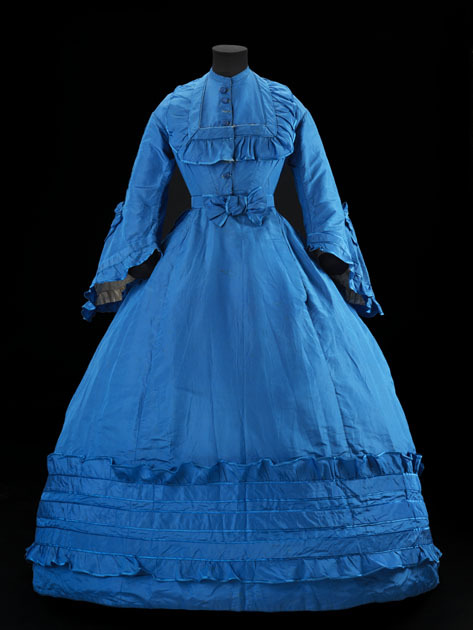

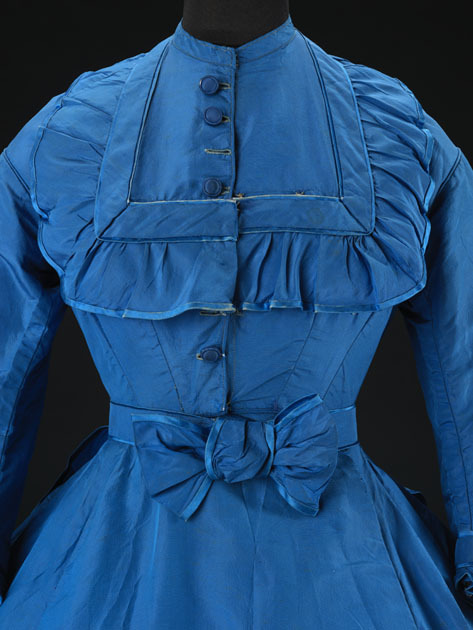
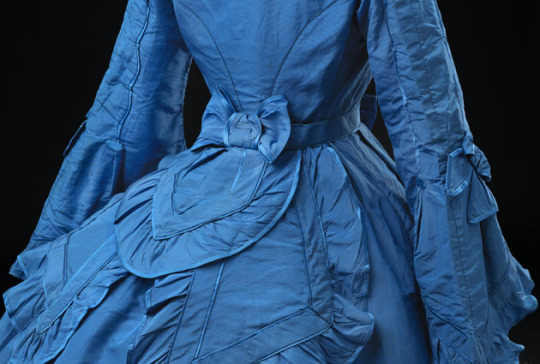
© CSG CIC Glasgow Museums Collection
That is the bluest kind of blue, and given its date (1866-1867) we know it's been dyed with the technologically cutting-edge aniline dyes of the period. As the museum (the Glasgow Museum) notes, some dresses of this era faded with time, but not so in this case.
You can already see the shape of this gown streamlining slightly, the bodice creeping toward the more tailored, masculine styles of the 1870s and 1880s. The monochrome look was very popular at the time, with the then-new House of Worth (who at the time was working with Bobergh). You can see very similar gowns from the duo at the Met, in fact, often in a gorgeous lavender hue.
#fashion history#costume#historical costuming#silk dress#textiles#costume history#threadtalk#victorian fashion#history of fashion
2K notes
·
View notes
Photo
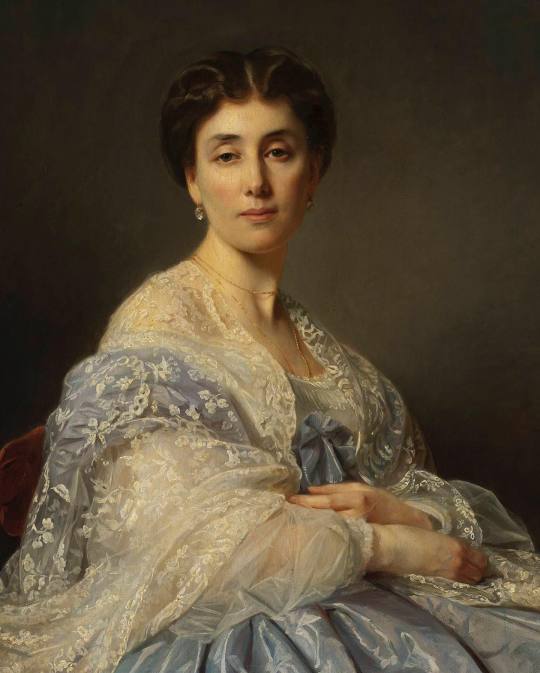
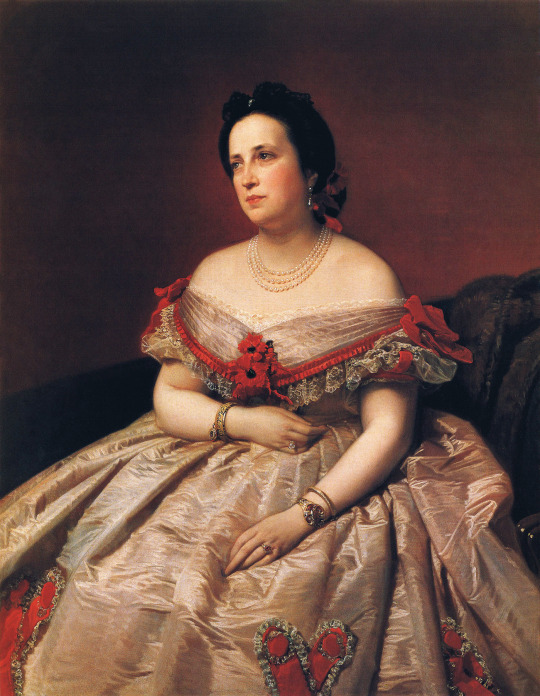


1860s dresses (from top to bottom) -
1862 Aleksandra Zatler, general’s wife, by Josef Simmler (location ?). From Merinok's Facebook pages 1440X1795.
1863 Rosa Guardiola, Baronesa de Andilla by Federico de Madrazo y Kuntz (private collection). From Wikimedia 1400X1804.
ca. 1865-1866 Afternoon dress (auctioned by Tessier-Sarou). From tumblr.com/fashionsfromthepast 1280X1920.
ca. 1867 Walking and visiting suit by Worth & Bobergh (Albany Institute of History and Art - Albany, New York, USA). From tumblr.com/history-of-fashion 1660X3072.
#1860s fashion#early Victorian fashion#Second Empire fashion#Aleksandra Zatler#Josef Simmler#wavy hair#lace wrap#off shoulder neckline#Rosa Guardiola#Federico de Madrazo y Kuntz#off shoulder V neckline#pleated bertha#lace bertha#full skirt#blouse#clerical neckline#bodice#deep V neckline#waist band#crinoline#Worth & Bobergh#high neckline#long full sleeves#bustle#petticoat#under-skirt
97 notes
·
View notes
Photo

Ball Gown
Worth & Bobergh
1860
Museum of the City of New York
#ball gown#fashion history#historical fashion#1860s#charles frederick worth#house of worth#1860#floral#flower print#france#19th century#antebellum#crinoline era#museum of the city of new york
280 notes
·
View notes
Text

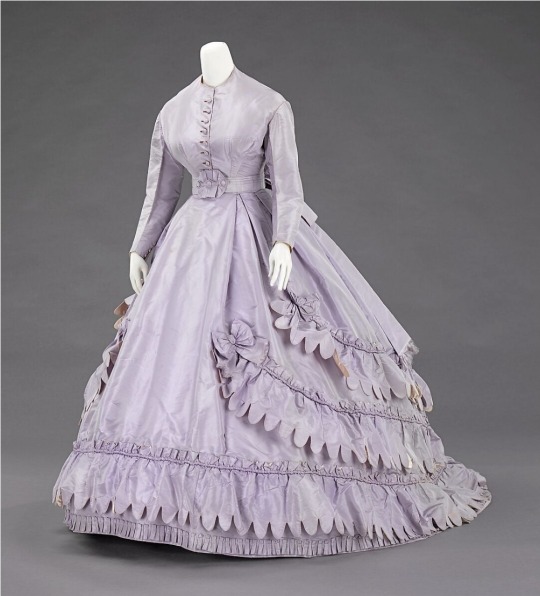

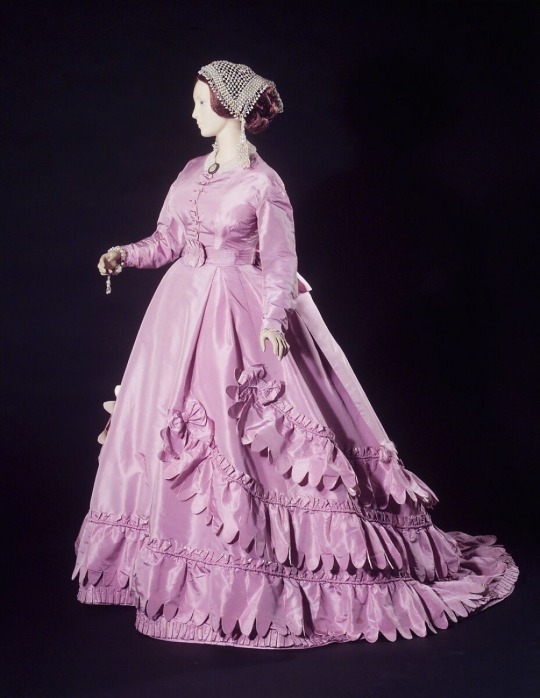
Title: Ensemble
Design House: Worth and Bobergh
Designer: Charles Frederick Worth (French (born England), Bourne 1825–1895 Paris)
Date: 1862–65
Culture: French
Medium: silk
#historical fashion#fashion history#19th century fashion#19th century#victorian fashion#1860s fashion
21 notes
·
View notes
Text
THE VICTORIAN ERA
Charles Frederick Worth (1826-1895)
'The father of Haute Couture' Charles Frederick Worth was born in 1825 in the market town of Borne, Lincolnshire. at the age of 11, he started working in a department store in London. in 1846 at the age of 21 Charles moved to Paris with little money in his pocket. He became a sales assistant at Gagelin-Opigez & Cie, where he sold silk fabrics, this is where he met his wife Marie Vernet which he married in 1851. Marie Vernet is considered now the first model.
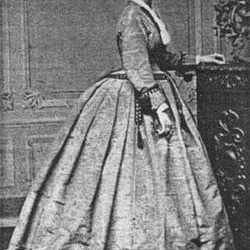

thedowntownallure. (2017). MARIE_VERNET_WORTH. [Online]. thedowntownallure.wordpress.com. Last Updated: April 5 2017. Available at: https://thedowntownallure.wordpress.com/2017/04/05/fashion-show-evolution/marie_vernet_worth/ [Accessed 1 January 2023].
Granger. (2012). Charles Frederick Worth. [Online]. fineartamerica.com. Last Updated: July 2nd 2012. Available at: https://fineartamerica.com/featured/charles-frederick-worth-granger.html [Accessed 1 January 2023].
Marie Vernet and Charles Frederick Worth
Charles began sewing simple dresses, and his work caught the eyes of the stores' clients, later he got given permission to open a dress department with a business partner Otto Gustaf Bobergh. This started in 1858 and was called Worth & Bobergh.

This was their first fashion label.
Alexandra Bosc. (2022). 19TH-CENTURY COSTUMES DEPARTMENT. [Online]. Palais Galliera. Available at: https://www.palaisgalliera.paris.fr/en/collections/collections/19th-century-costumes-department [Accessed 1 January 2023].
His wife Marie Augustine Vernet played a significant role in the brand, such as selling the clothes and introducing many customers
in 1871, Worth cut off his business with Bobergh and established his own brand called 'House of Worth'. Specialising in Haute Couture, Ready to Wear, and perfume. He also hosted his first fashion show to display his work

House of Worth at 7 Rue de la Paix, Paris in 1894
Fredericks's skills in dressmaking made him the official dressmaker of Empress Eugenie, the last empress of France
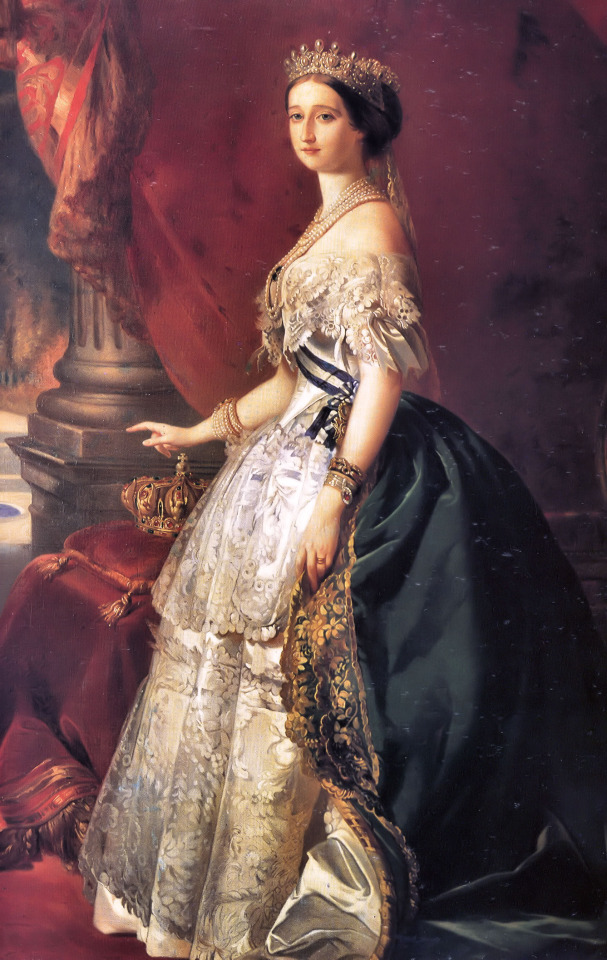
This is empress Eugenie in his work
CUSTOMERS OF CHARLES FREDERICK WORTH
Elizabeth of Austria, Jenny Lind, Lillie Langtry, Sarah Bernhardt, and many more.
SOME DESIGNS OF CHARLES FREDERICK WORTH
Jessa Krick. (October 2004). Charles Frederick Worth (1825–1895) and the House of Worth. [Online]. Met Museum. Available at: https://www.metmuseum.org/toah/hd/wrth/hd_wrth.htm [Accessed 1 January 2023].
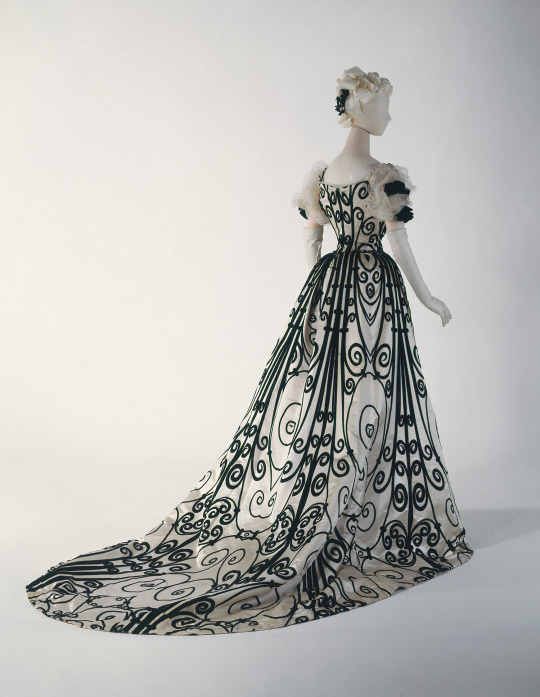


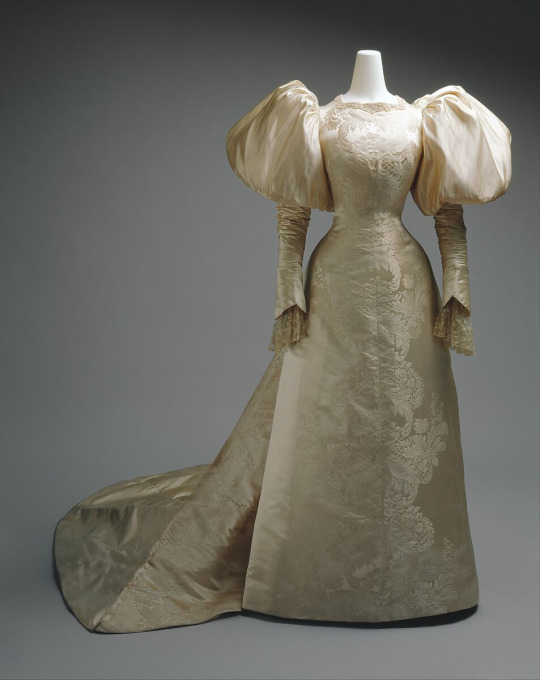
his work included a large amount of silk, and the silhouette of his work was the voluminous dresses that dominated this era, these dresses were a brand-new fashion that spread across the globe. the beautiful materials used to elevate these dresses to luxury, dresses included ruffles, striped and floral.
The Visite was a coat that was fashionable with the bustle style, it had slits to accommodate the fullness of the back of the dresses. The designs on the back were designed to emphasize the bustle. this work was finely detailed and took immense talent.

The Visite
Some of Worths included lace ruffles, intricate designs, silk satin, and gorgeous fabric. Later on in his designs, the skirts reduced in size, and around 1890 the shoulders expanded, and gigot sleeves. The sleeves became stiffer and bigger, reaching their biggest in 1895.


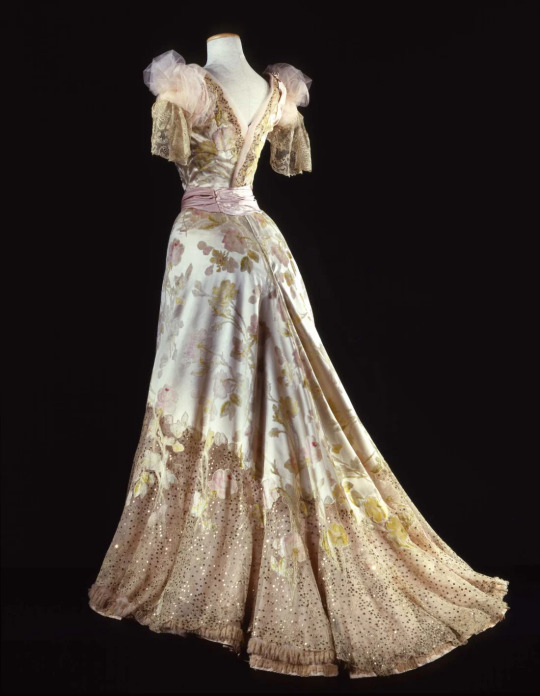
Jessa Krick. (October 2004). Charles Frederick Worth (1825–1895) and the House of Worth. [Online]. Met Museum. Available at: https://www.metmuseum.org/toah/hd/wrth/hd_wrth.htm [Accessed 1 January 2023].
Frederick had two sons Gaston and Jean, which in 1874 joined the business to help with management, finance, and design. this gave Charles time to enjoy his life in his later years as he struggled with a variety of health problems. Unfortunately in 1895, Charles Frederick Worth died of pneumonia at the age of 69.
1 note
·
View note
Photo

"Robe Composée" de Worth & Bobergh (circa 1869) et "Robe en DEux Parties" (1877-80) présentées à l'exposition “Une Histoire de la Mode” du Palais Galliera, octobre 2021.
5 notes
·
View notes
Photo

Silk ensemble, c. 1862–65 Worth and Bobergh. Extant garments by Worth & Bobergh are very rare. This is an example of the elegant simplicity with which Charles Frederick Worth made his reputation. #history #museumcollection #antiquetextile #instamuseum #museumoninstagram #antiquesilk #historicaldress #costumehistory #fashion #historicalfashion #historicalclothing #dresshistory #fashionhistory #historicalcostume #fashionhistorian #19thcentury #19thcenturyfashion #worth #houseofworth #bobergh https://www.instagram.com/p/B2JzkPkAGlh/?igshid=11e9f792lnell
#history#museumcollection#antiquetextile#instamuseum#museumoninstagram#antiquesilk#historicaldress#costumehistory#fashion#historicalfashion#historicalclothing#dresshistory#fashionhistory#historicalcostume#fashionhistorian#19thcentury#19thcenturyfashion#worth#houseofworth#bobergh
3 notes
·
View notes
Photo

Worth & Bobergh gown, 1861, silk satin,Chicago History Museum.
394 notes
·
View notes
Text
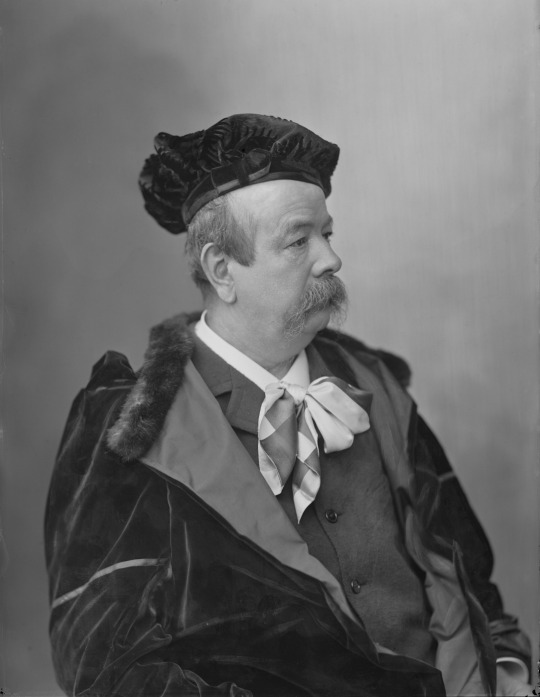
Charles Fredrick Worth didn't invent couture, but he absolutely re-invented it and made it what it is today.
Born to two textile merchants in Lincolnshire, he followed his parents into the textile business, apprenticing in London. Eventually, he re-located to Paris in 1845. There he worked at luxury textile firm Gagelin, becoming their lead salesman and eventually, a dressmaker. His designs quickly drew attention and garnered accolades. In 1858, he started his own firm, Worth and Bobergh.
On top of his unique talent for design and dressmaking, Worth came along at a good time. The French monarchy had been restored, once again placing the royal court and Empress Eugénie at the center of the French fashion world. The industrial revolution also created a new class of wealthy clientele and a new demand for luxury, hand-made goods. While Worth was very much a gifted dressmaker, perhaps his greatest talent was self-promotion.
Worth understood the value of a personal relationship between a dressmaker and his clients. One of his revolutionary ideas was while previously, a dressmaker would go to a client's home, Worth had his clients come to him, inventing the couture house. Once there, they could choose from a vast selection of fabric, consult with the designer on what they wanted, and get fitted for the perfect garment. It was an experience. House of Worth became more than just a salon, it was a social hub where the rich and glamorous could gather. Worth was also innovative in that he was the first designer to use live models rather than mannequins to showcase his creations.
Beyond that, he also courted the masses, with his designs appearing in Godey's Lady's Book and across the ocean in American publications. He courted celebrities like Jenny Lind and Sarah Bernhardt, dressing them for their appearances and performances. A LOT of later designers get credit for being the first to work with celebrities or using promotional stunts, but Worth was the one who did it all first.
107 notes
·
View notes
Text
Another Shadow and Bone Costume Post...
@orlissa, you really shouldn't GIVE me the chance to assign gowns to characters like this. I get far too into it...
@vesperass-anuna, @pia-bartolini, @jomiddlemarch, give me your dress headcanons too!
Right, where to begin!

1) Woman’s Dress,” c. 1866–68, designed by Charles Frederick Worth, label Worth & Bobergh, Paris - You nailed it! This is DEFINITELY Alina.
There's a subtlety about that gold/cream that says Sun Summoner, but - in a gentle, refined way. (ALSO - although Alina may not have had a "proper" wedding ceremony in Terrible Beautiful Unsaid Things, I have a sneaking suspicion Aleksander apologises to her by having a gorgeous 'wedding anniversary' celebration ball the next year, where she wears this...)

2)“Woman’s Dress,” c. 1866–68, designed by Charles Frederick Worth, made by Worth & Bobergh, Paris

Genya. This is 100% GENYA. There's a cleanness, elegance and lack of fuss about this that feels very Miss Safin. She's avoiding the 'dressed like a wedding cake look' the Court demands. Plus tell me that colour wouldn't look AMAZING with her red hair. She would look like a Fae Queen, and David would 100% be heart-eying her behind her back.

3)“Woman’s Evening Dress,” c. 1886–87, designed by Charles Frederick Worth

I don't know what is is about this one - the perky bow on the front? that dash of deep crimson (Heartrender?) red? the gorgeous embroidered flowers with that yellow train?

But this feels very "Fancy Nina" to me - possibly acting as a Grisha Ambassador to Kerch whilst spying, or something. It's got her irrepressible nature as well as her skills and subtlety there. (AND the bow on the bodice is at just the right height to ahem, "distract" Matthias...
4)“Woman’s Day Dress,” c. 1878–80, designed by Charles Frederick Worth

Another Alina for me, I'm afraid! The colours with the golden flowers and that luxurious black silk are SO 'Darkling Sun Summoner Kefta' it hurts. I love it deeply.
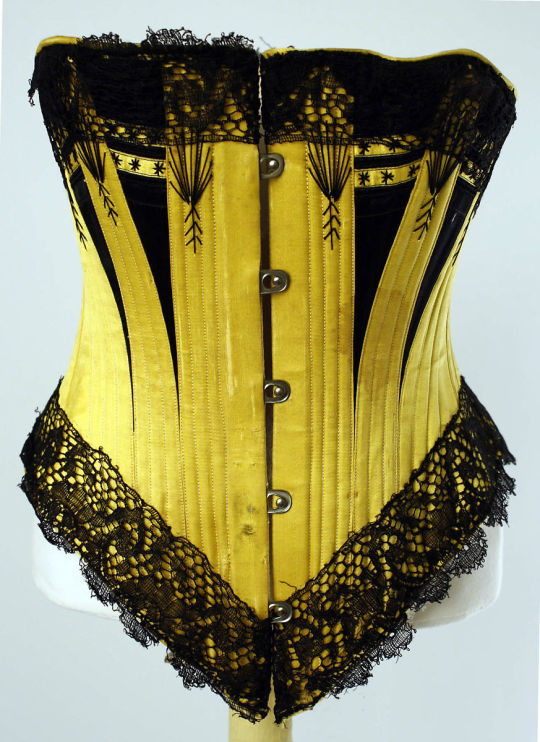
(and... you just KNOW Alina is probably wearing THIS corset beneath it, which... ahem, Aleksander probably makes this face when thinking about...)

(Sorry for the unexpected Darklina thirst there, guys - oh who am I kidding, I apologise for nothing)
“Woman’s Evening Dress,” c. 1886–87, designed by Charles Frederick Worth

This feels like "Deliberatively Provocative Nina", to me. The pink, the tantalising low neckline, the outrageous lace and embroidered silk and ribbons? This is all worn to provoke an uneasy 'Fjerdan Women are modest and would never dress so...so shamelessly' lecture from Mathias that you just KNOW is going to end up in a heated make-out session - with the offending dress on the floor.
#shadow and bone#ravkan fashion squad#I... apparently have headcanons#and otps for dresses?!#oh dear#give alina all the gorgeous gowns#everyone deserves worth gowns#genya safin#alina starkov#nina zenik#fashion history#charles frederick worth#darklina
59 notes
·
View notes
Text



"Afternoon Jacket with silk and beads. 1895. House of Worth (French, 1858–1956).
Designer: Attributed to Charles Frederick Worth (French (born England), 1825–1895 )
Designer: Attributed to Jean-Philippe Worth (French, 1856–1926)
Every element of this Worth jacket is of the highest quality, as expected of the preeminent house in the 1890s. Worth studied and often reinterpreted historical fashions as can be seen here in the back configuration, collar and overall decorations which evoke 17th-century menswear.
Charles Frederick Worth was born in England and spent his young adulthood working for textile merchants in London while researching art history at museums. In 1845 he moved to Paris and worked as a salesman and a dressmaker before partnering with Otto Bobergh to open the dressmaking shop, Worth and Bobergh, in 1858. They were soon recognized by royalty and major success followed. In 1870 Worth became the sole proprietor of the business. At his shop, Worth fashioned completed creations which he then showed to clients on live models. Clients could then order their favorites according to their own specifications. This method is the origin of haute couture. Worth designed gowns which were works of art that implemented a perfect play of colors and textures created by meticulously chosen textiles and trims. The sheer volume of the textiles he employed on each dress is testimony to his respect and support of the textile industry. Worth's creative output maintained its standard and popularity throughout his life. The business continued under the direction of his sons, grandsons and great-grandsons through the first half of the twentieth century.
Jean-Philippe Worth began as an assistant to his father, Charles Frederick Worth, in 1875. Gradually he was allowed to create his own designs and when his father died in 1895, he became the lead designer for the house. He was praised for making elaborate artistic gowns with intricate trimmings on unique textiles, much like his father had before him. Although the House of Worth was still favored by royalty and celebrities through the turn of the century, their styles were no longer the forefront of French fashion after 1900. Around 1910 Jean-Philippe limited his design work to important orders and hired his nephew, Jean-Charles Worth, as the new lead designer before leaving the company entirely after World War I.
Credit Line: Brooklyn Museum Costume Collection at The Metropolitan Museum of Art, Gift of the Brooklyn Museum, 2009; Gift of the Princess Viggo in accordance with the wishes of the Misses Hewitt, 1931".
4 notes
·
View notes
Photo

Walking Dress
Worth & Bobergh
c.1867
Walking dresses, to be in good taste, should be of quiet colors, and never conspicuous. Browns, modes, and neutral tints, with black and white, make the prettiest dresses for the street. Above all, avoid wearing several bright colors. One may be worn with perfect propriety to take off the sombre effect of a dress of brown or black, but do not let it be too glaring, and wear but little of it... Let the materials be of the costliest kind, if you will, but do not either wear the exaggerations of the fashion, or conspicuous colors. Let good taste dictate the limits where fashion may rule, and let the colors harmonize well, and be of such tints as will not attract attention. - Florence Hartley in The Ladies’ Book of Etiquette & Manual of Politeness (Project Gutenberg)
Albany Institute of History & Art
#walking dress#fashion history#historical fashion#charles frederick worth#1860s#worth and bobergh#19th century#brown#silk#france#second french empire#second empire#albany institute of history and art
760 notes
·
View notes
Photo

Pale Blue Afternoon Dress, Worth & Bobergh / 7. Rue de la Paix 7 Paris Maker, c.1867,Charles Frederick Worth and Otto Bobergh (active together 1857-1870)
Designer. Silk taffeta and silk faille. Gift of the estate of Maurice Moore, in memory of his wife, Mary DeCamp Banks Moore. ALBANY INSTITUTE OF HISTORY & ART
3 notes
·
View notes
Photo
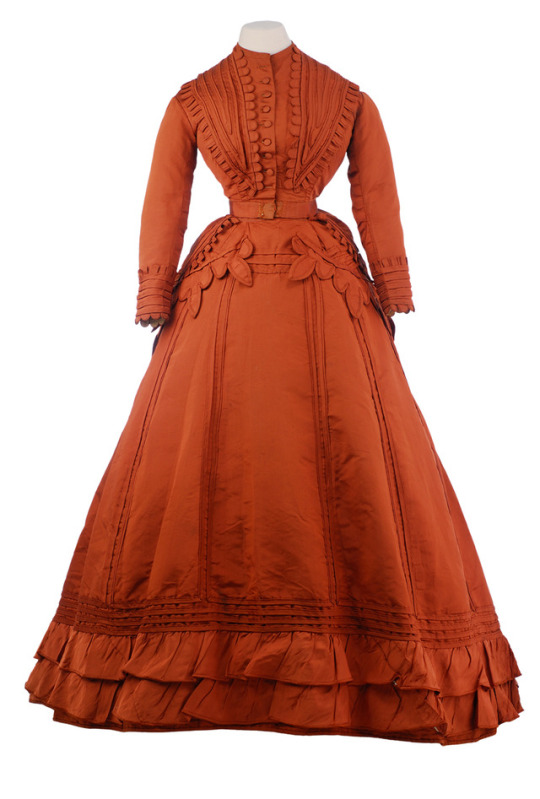

• Dress.
Date: 1867-1870
Maker/Manufacturer: Worth & Bobergh
280 notes
·
View notes
Photo

ab. 1866-1868 Woman's Dress with Day and Evening Bodices (Made by Worth & Bobergh, Paris, France)
silk faille, silk tulle
(Philadelphia Museum of Art)
134 notes
·
View notes